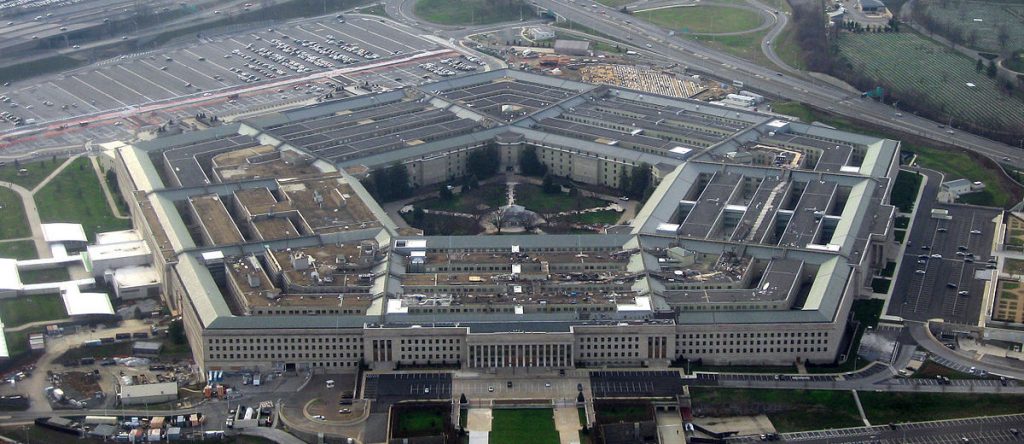A new report to Congress on China’s military prowess by the Department of Defense (DoD) highlights just how fast the CCP has managed to grow its defensive and offensive capabilities. In a matter of a little more than a decade, China has accomplished what no developing nation has done before it. What the report does not say is that a large part of those military capabilities were helped along by American capital – whether that capital came from Wall Street, Silicon Valley, or American multinational tech companies.
In its 212-page annual report titled “Military and Security Developments Involving the People’s Republic of China”, the Defense Department warned that military-to-military communication between Washington and Beijing was on the wane. And that China’s military was increasingly capable to fight and win wars against a strong adversary.
China’s main reason for its investments in defense, the DoD seems to surmise, is to counter the U.S.
China’s national strategy is to achieve “the great rejuvenation of the Chinese nation” by 2049. The strategy is a determined pursuit of political, social, and military modernity to expand the PRC’s national power, perfect its governance, and revise the international order in support of the PRC’s system of governance and national interests. The PRC views the United States as deploying a whole-of-government effort meant to contain the PRC’s rise, which presents obstacles to its national strategy. China characterizes its view of strategic competition in terms of a rivalry among powerful nation states, as well as a clash of opposing ideological systems. Chinese leaders believe that structural changes in the international system and a confrontational United States are the root causes of intensifying strategic competition between China and the United States. – from the Defense Department’s Annual Report to Congress, released Oct. 19, 2023.
In March 2023, Xi Jinping told delegates to the Chinese People’s Political Consultative Conference – part of China’s intelligence apparatus tied to CCP leadership in Beijing – that “Western countries led by the United States have implemented comprehensive containment, encirclement and suppression against us, bringing unprecedented severe challenges to our country’s development.”
From Defense to Consumer Goods: Is There a Difference?
The report noted China’s Military-Civil Fusion (MCF) Development Strategy to “fuse” its defense contractors into its so-called Integrated National Strategic System and Capabilities in support of China’s economic goals.
This MCF strategy includes objectives to develop and acquire advanced dual-use technology for military goods (think microchips that can be used to pilot an autonomous naval ship like the Zhu Hai Yun, or the DJI drones for sale to retail American consumers on Amazon) and deepen reform of the national defense science and technology institutions to better serve as a more broad purpose of strengthening China’s industrial strength.
Since Washington has caught onto this strategy, leading to some export restrictions of American technology sold to certain Chinese companies, Beijing has changed the term “Military Civil Fusion” and now uses a more academic, less catchy terminology: “integrated national strategic systems and capabilities,” the report said.
China’s Military: Best in Asia?
The DoD isn’t worried about the Indian military, or even the Russian. It’s China’s military that worries them. China is arguably the best-equipped fighting force in Asia, based on how the DoD report describes them.
The People’s Liberation Army (PLA) continues to modernize equipment and focus on combined arms and joint training with other countries in an effort to meet the goal of becoming a world-class military.
The PLA recently demonstrated a new long-range missile capability in the PLA military response to the August 2022 U.S. Congressional Delegation visit to Taiwan. The PLA continues to incorporate a twice-a-year conscript intake, meaning they have men of fighting age ready to go. The long-term effects of this are not clear, however, the DoD said.
Meanwhile, the PLA’s Navy has the largest navy in the world, as measured by the number of sea vessels. It has an overall battle force of over 370 ships and submarines, including more than 140 major surface combat ships, of which a handful are now in the Persian Gulf since Israel and Hamas began a shooting war this month. The Chinese Navy is mostly composed of modern multi-mission ships and submarines and last year, they launched their third aircraft carrier, the CV-18 Fujian, which some have compared to the slightly larger U.S.S. Gerald Ford. Both carriers use electromagnetic catapults to launch fighter plans. Nearly all of the rare earth minerals that go into making those magnets are either sourced from China, or processed from rock to powder form by Chinese companies. China not only is a major supplier of U.S. defense goods, it is also a recipient of tens of millions of dollars of American investor capital.
The report focused solely on China’s military capabilities. How it got there may also warrant attention.

Here’s an example of how a Chinese company can face restrictions by the Commerce and Defense Departments, but can still sell its wares to American consumers on Amazon. Many such examples exist, from Wall Street funding defense contractors and investing in companies banned from selling here due to the Uyghur Forced Labor law.
Americans Funding the ‘China War Machine’
Both the Trump administration and the Biden administration took actions against U.S. investor capital going to buy the stocks and bonds of dozens of Chinese defense contractors. Prior to these bans, which demand divestment by August 2022, Wall Street’s biggest investment firms all had millions of shares of Chinese defense companies.
For example, CSSC Holdings Ltd. (SHA:600150) is the publicly traded arm of China State Shipbuilding Corporation Ltd. (CSSC), a Chinese state-owned enterprise carrying out shipbuilding and repairs for cargo customers and Navy military vessels. This is where the Fujian aircraft carrier was built. CSSC is included in some of the world’s most prominent investment indices and was a holding of every mutual fund and exchange traded fund that tracked those indices.
On Oct. 12, CPA released its findings on defense companies and their subsidiaries whose shares are held by Vanguard. The Financial Times wrote about the report, saying, “Vanguard, the world’s second-largest asset manager, is acting as a pipeline through which U.S. investment dollars are being funneled into Chinese military companies.” None of these companies are banned by Treasury, but many of their parent companies are banned. Regardless, the point stands: U.S. capital has, and continues to be, a source of capital for the very entities the DoD is writing about in its report.
Companies that face export restrictions are also not off limits to American investors. It is not easy to sell computer hardware to ZTE Corp, one of China’s telecom giants on the Commerce Department’s Entity List. But as of Oct. 24, Vanguard and BlackRock owned around 44 million shares combined, according to Morningstar. Based on the exchange rate between the Hong Kong dollar and the U.S. dollar, that is roughly the equivalent of $100 million investment in a company Commerce believes is a military-civil fusion player.
There are at least five Entity List companies that need Commerce Department permission to access American technology, but no permission to access American capital. This is just another example of how the U.S. has helped to fund the CCP’s military rise.
A perennial trade deficit in manufactured goods, coupled with China’s control of numerous supply chains handed over to them by American companies who offshored labor, has given China a leg-up on every other developing country. No other developing country in China’s neck of the woods, or in Latin America, has grown so fast. Clearly, not all of that growth is due to the genius of China’s central planners, or its hard-working population.
Supply Chains & Derisking
Among the external elements of China’s national strategy are its efforts to create a “favorable” international environment that is conducive to China’s soft power as it relates to their economy and diplomacy. In the 20th Party Congress Political Work Report, published in October 2022, the CCP expanded on its calls to prepare for geopolitical stresses from the U.S. and Europe, and prioritized securing and safeguarding its national interests. In it, the CCP stressed the need to strengthen the country’s capacity to secure its markets, including improving its control over grain, energy, and key industrial supply chains, the DoD report noted.
The DoD report said that China’s goal is to innovate, manufacture, and consume within its own economy, while still drawing on the international economy for export markets, being big players in critical supply chains, and less reliant on foreign capital. China is not interested in the kind of globalization espoused by many in Washington, London and Brussels.
China is very good at taking a China-first approach, and the risk of that seems worth noting. The report makes no comment at all on this. The word’s “derisking” and “decoupling” are nowhere to be found. Decoupling is definitely not part of the DoD’s lexicon when it comes to China.
Writing in Foreign Affairs magazine on Oct. 24, one of the two main magazines for Washington foreign policy mainline thought, National Security Advisor Jake Sullivan said, “the economic relationship with China is complicated because the country is a competitor. We will make no apology in pushing back on unfair trade practices that harm American workers. And we are concerned that China can take advantage of America’s openness to use U.S. technologies against the United States and its allies. Against this backdrop, we seek to de-risk and diversify, not decouple.” This is what the U.S. defense industry says.
Greg Hayes, the chief executive of Raytheon (now known as RTX), said in June that the company can “derisk” but cannot decouple. “We have several thousand suppliers in China. Decoupling is impossible,” he said.
Ironically, just two months prior to Hayes’ comment, senior executives from his company and Lockheed Martin were banned from China.
The DoD said that China’s long-term goal is to create an entirely self-reliant defense-industrial sector—fused with a strong civilian industrial and technology sector—that can meet the country’s needs for modern military capabilities. In 2022, China announced its official annual military budget would increase by 7.1 percent, continuing more than 20 years of annual defense spending increases and sustaining its position as the second-largest military spender in the world after the U.S.
Last week, CPA called on its members to write to Congress to help boost manufacturing of semiconductors in the United States. The industry was heading to Asia quickly, until the CHIPS Act helped reshore some investment in new chips domestically. More needs to be done, as U.S. defense contractors often need lower-end chips, known as “legacy” chips, which are commodities in the microchip business and are largely all made in China, Taiwan, and South Korea.













